|
The smell of wood resin
and wood dust precedes William Kent's barn in Durham,
Connecticut by about 100 yards. As you make the final
turn on serpentine Howd Road—after passing cow pastures,
woodlands, vine-choked ponds and creeping suburbia—Kent's
lime-green door appears, a visual beacon that most people
simply speed past.
Why shouldn't they? They
have no way of knowing that inside lives and toils one
of the world's master artists. Private by nature, the
solitary William Kent once preferred it that way. But
now, having turned 82, Kent is beginning to wonder why
the larger world—meaning the major institutions dedicated
to art and culture—have not beaten a path to his
door. This is not just some idle pipe dream of a hobbyist
or second-rate talent but a valid complaint from a forgotten
master. William Kent, according to an art critic cited
in a New York Times article about him, is "the
world's greatest living carver of wood. There's not even
anyone close."
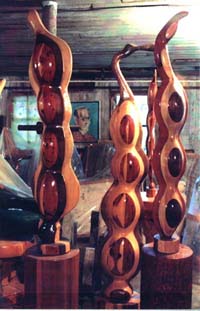 |
That, apparently, is part
of the problem. Woodcarvings and wood sculpture are not
"in" right now in the art world, nor have they been since,
well, Kent began carving in the late 1940s. Over half
a century later, he still can find no place to show his
work and only manages to keep afloat by selling a large
piece now and again to a die-hard collector who has been
led to Kent's door by one of his devotees.
If that seems implausible,
imagine how it feels to Kent, who rises each morning at
4:30, dons his wardrobe of sweatshirt, jeans and work
boots and then trudges the few dozen feet from his monk-like
living quarters to the frigidly cold barn. After working
for five hours, he takes a break for a light repast and
some relaxation playing the piano. Then he is back at
the wood—chipping, grinding, sanding, varnishing
and planning his next day's goal. His work ethic is as
astounding as his output.
Indeed, Kent carves wood
the way Picasso painted: striving for the simple but profound
beauty of form. In fact, he bears a passing physical resemblance
to Picasso and shares some of the master's Promethean
talent, as well as his penchant for not suffering fools.
"People look at my carvings and ask, 'What can you do
with it?' How do you answer that?" Kent resignedly offers,
"Wood carving is not fashionable. A narrow group runs
the art world, and I don't fit into it."
Despite some nagging minor
health problems, Kent looks about 20 years younger than
his age and is as vigorous in mind as he is in body. He's
a voracious reader of world history and philosophy, an
avid listener to opera and progressive radio and is more
informed on world events and political trends than most
of the so-called pundits.
"I think the Axis of Evil
is really the White House, the Supreme Court and Congress,"
he says, in one of his kinder, gentler assessments of
the current political scene.
***
Like buried treasures,
hundreds of Kent’s carvings—most standing taller
than he—are stored under tarpaulins in his barn.
They are everyday objects he re-creates in wood: giant
shoehorns, pipes, ladles, vises, calipers, razors, safety
pins, plugs, eyeglasses, corkscrews, shoes, lightbulbs,
shell beans, bell peppers (one fashioned into a "Self
Portrait With Erection"), octopods, reptiles, dental plates.
This is not whittling on a grand scale but is, instead,
a complicated artistic process that produces all of five
or six complete works per year. Defying belief, most of
his sculptures are carved from single pieces of wood purchased
from sawmills.
The process starts with
a sketched idea, then a selection of the type of textured
wood he wants to use. Kent prefers "native wood" such
as poplar, red cedar, black walnut, white pine and mahogany,
but he's not afraid to use green wood or even telephone
poles. "Some idiot told me 'You can't carve green wood,'
but I've had chips fly off my carvings that were so green
they left wet marks on the floor," he explains.
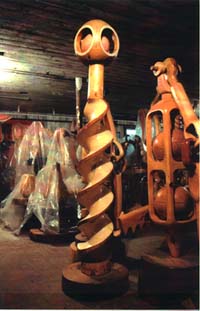 |
Lately, Kent has been working
with different types of wood that he fuses together and
then carves, as if one huge block of wood. He just completed
a series of otherworldly shell beans "abstracted out and
laminated" with cherry in the center, poplar and walnut
around the edges. He has embarked on another series—eyeglasses
so large and wide that they seem, like World War I biplanes,
prepared to soar down the runway. Most of his carvings
are at least as tall as he is and include elegantly rendered
pedestals.
As he stands among
these remarkable creations, Kent begins to talk. He has
lived alone in this barn since 1964, when he was summarily
dismissed as curator of the John Slade Ely House in New
Haven for a showing of his erotic slate prints in a New
York gallery. As a graduate student at Yale, he studied
music under Paul Hindemith and began painting on his own.
He then moved on to printmaking; his carving arose naturally
from the cutting of slates for his prints. "I never studied
art at Yale," he says, with no sense of irony. "If I had,
I wouldn't be doing this kind of original work."
He has grown weary of the
"poor old man, curmudgeon, recluse" angle the media seems
to prefer when confronting someone in his current predicament.
This approach, he says, implies that his work is "not
good enough to sell, probably not commercially viable
in the first place, because everyone knows that if an
artist is good, he sells." Kent bristles at the suggestion
that he's "hiding" his work and produces a lengthy document
itemizing every rejection he's gotten since 1980. Among
the typical responses was one from Wesleyan (University)
Art Gallery: "We have to have credentials, Mr. Kent."
Or another from the New Britain Museum of American Art:
"repetitive." Or one from the lowly Mystic Seaport Gallery:
"We want something small we can sell."
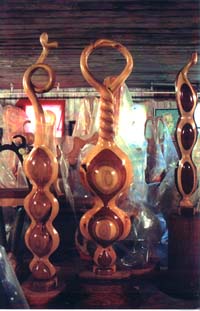 |
Kent cannot be blamed for
recoiling at the process of approaching these sorts of
second-rate venues. But what really hurts is the utter
silence from the places where his work should be: the
National Gallery of Art, the Museum of Modern Art, the
Hirschhorn, the Guggenheim, the Corcoran and the Whitney.
He would be no stranger to the Whitney. In the 1960s,
his slate prints of satiric and erotic subjects were included
in the Whitney Biannual next to work by Jasper Johns,
Robert Rauschenberg and Roy Lichtenstein. This did not
necessarily console him at the time, and it does nothing
for him now.
"Modern art has triumphed,"
says Kent, who views Johns, Warhol and Lichtenstein as
"the fashionable interior decorators of our time. When
they teach modern art in the Yale School of Design, you
know it's finished, a dead style. I can remember when
I came to Yale School of Music in 1944; modern art had
not touched Yale. They had a guy there called Eberhard,
who said he studied with Rodin. That was the style they
worked in at that time—tempura painting from the
Renaissance to the late 19th century. All of a sudden,
they flipped over and went modern when Joseph Albers came
in the 1950s."
Kent has no patience and,
in fact, a great deal of derision for the "sensationalist"
bent of contemporary art. "Museums have a right to show
that international garbage style…but like it or not,
doesn't my record of years of accomplishment, barely equaled
by few other artists around here, deserve some recognition?"
he asks, adding, "These sensationalist shows are here
today, gone tomorrow."
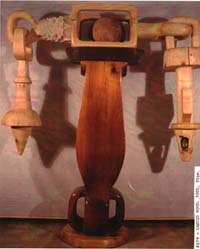 |
In recent years, Kent has
unenthusiastically enlisted the aid of art agents, with
mixed success. He gave up the effort when one of them
booked him at an "outsider art" exposition. "I seem to
be 'outside,' so to speak, because my work is so highly
finished. People look at it and say, 'Oh, it's craft work.'
Craft work? That's crazy. Look at a piece like this,"
he says, unwrapping a breathtaking work from 1961 of a
man kneeling with a wasp and praying mantis on his back,
all carved from one piece of black walnut. And another
work, from 1964, of a mahogany hand holding an alabaster
cricket. And another, from 1968, of a water faucet with
a chain flowing from its spigot—all made from one
piece of cedar. Still another, from the same year, of
an eagle with a duck's face seated on a trash can that
has tires so realistic you have to feel them to be sure
they're wood; at the duck's feet is a perfectly rendered
egg in alabaster, a zipper running along its top. "They
don't seem to accept this as art," he says. "That's what
I'm up against."
Despite the art establishment's
apathy, Kent's work shows no slackening in technique or
vision. In fact, it has never been better, evoking comparisons
to Rodin and Constantin Brancusi. He is a bit wary of
such comparisons, though, but not because he doesn't admire
these masters. He just thinks such comparisons are misleading.
"People have said that
I got my ideas from Brancusi, but where did Brancusi get
his idea for spiral forms? From African pole-carvings,"
says Kent. "Brancusi was a great influence, though. He
was the first major sculptor since Michelangelo to carve
directly into marble and other materials. Before Brancusi,
all the sculptors were either making plaster casts and
farming the work out to be made or using a pointing machine
to drill down into their medium and then cut out from
there. When I arrived at Yale in 1944, there was a big
pointing machine in the basement of the School of Art.
I never did that. I carve directly into the wood, like
Brancusi."
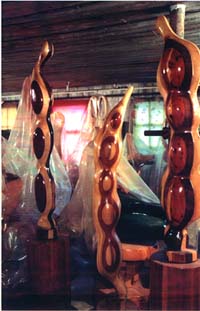 |
Asked, then, what his options
are, Kent simply says, "Do your work and die." Many of
his old friends have died. In his barn, hidden by plastic
tarps, are two oil portraits of Kent painted by friends
who both died in the past decade—Bill Skardon and
Sophie Cohen. The one by Skardon, a friend from Kent’s
Yale days, is particularly touching. Done in 1957, its
freshness and square-jawed virility nearly leap off the
wall, a glimpse of Kent's timeless aura of clarity.
Of his friend, Kent says,
"Bill was a fine artist, but he never had a break in the
art world. He studied art at Yale, but it didn't hurt
him much. He had his own individual style, so they couldn't
knock the originality out of him."
The comparisons to his
own situation are left unstated, hanging in the air with
the wood dust and the resin. "Someone told me, 'One day,
every museum will want one of these wood carvings.' But
not now. All the great artists went through the same thing.
Take Kandinsky. I just read a book," Kent begins, but
his voice trails off, as if he knows he's wasting his
breath. Or perhaps he has simply glanced above his bed,
where one of his slate prints hangs. On it are the words
of e.e. cummings: "Honesty Is The Best Poverty." This
could be the motto of William Kent.
Anyone
interested in Bill Kent's work can contact him directly
at 269 Howd Road, Durham, CT 06422, or 860-349-8047.
|